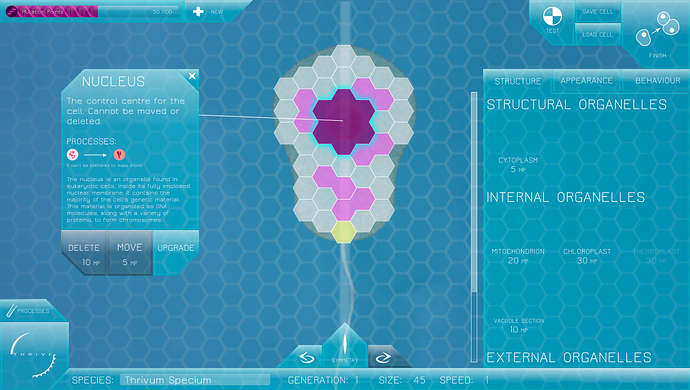So we’ve made it quite a ways since the days Thrive’s vapourware childhood, so I think we should all give ourselves a pat on the back for that. But, now that we’ve got the barebones of the game in place, we need to work on making it fun. I think the next release is a prime candidate to be a release to focused on gameplay and new features (though if we can slide in as many of the minor graphics changes that I suggested on this thread as possible that would be awesome).
So, in the same vein as that linked thread, I think we should use here to brainstorm features and changes we could implement to make the game more fun. I’ll begin, but let me know what suggestions you guys have as well!
Improved Tutorial and Tooltips
I think many players have trouble understanding how the game works, what certain organelles do, etc. and this makes it very difficult to enjoy the game’s features if you can’t even make sense of them. I think we should add tooltips to the organelles in the editor, and add some additional info either in the tutorial or the help button about how the new reproduction system works and anything else people might be confused about. It would also be good to add some way of conveying to the player that they are in engulfing mode versus not.
Species Mortality
Currently, you cannot lose the game. You can die countless times and will always respawn. If we add some form of mortality not only to the player’s organism, but to their entire species, putting them at risk of extinction if they die too many times, I think that would help a lot. We don’t need the full CPA system in place here yet to track their population, we can just use a simple placeholder algorithm for now to determine extinction.
Predatory NPCs
The NPC cells in the game are currently very docile. The worst I’ve seen is a cell that tried to engulf me but only because I was right beside him. The toxic cells are mightily annoying, but they don’t actually hunt you down, they just congregate in certain areas and pump out poison. We need to make an AI for predatory cells that will make them actively hunt down the player cell and other cells around.
Compound Cloud Changes
I think we should make compound clouds bigger, but more spread out. By this I mean the clouds should be harder to find, but when you do find one you get more out of it. This makes finding a cloud more challenging and more rewarding, and means you can last for longer between the clouds because you get more from them. This also means that instead of having to swim through 5 different clouds of glucose and 5 different clouds of ammonia to heal, 1-2 should be enough.
Also, in my opinion, the compound clouds disappear too fast. Sometimes I see an ammonia cloud, but by the time I turn and swim to it it’s gone, so it’s actually more efficient to just swim in a straight line and just swim over the clouds you want by chance because you are moving so fast, than to sacrifice your momentum to turn and potentially miss getting the cloud.
Fluid Mechanics
Your cell, NPC cells, free floating organelles, and compound clouds should all be subject to motion from fluid mechanics. Not only is it a little odd to see a cell without flagella perfectly motionless, it also makes things more challenging, and in my opinion fun, if currents will carry you around. Now obviously, the currents will not have to be strong enough to overpower flagella or make you feel powerless, but it should definitely be a factor in how you move and plan where to go, sort of like a ship that aims its sails to go with the wind but could still go against the breeze if it wanted to, just with more difficulty.
Cell Generation Changes
I think currently too many cells spawn with toxin vacuoles, and it gets quite frustrating, because when you get damaged all reproduction progress stops or even reverts until you can heal again. In my opinion toxin predators should be a rare and exotic predator, not an abundant cell type, so that when you do run into them it’s much more of a “OH BELGIUM” moment. In addition to more aggressive predatory AI, it should make running into toxin predators exciting/intimidating.
Organelle Upgrades
Yes @TheCreator I think it’s finally time to bring your brainchild to life. I think adding in the ability to upgrade your organelles adds a level of progression to the game that it doesn’t have right now. There is a little bit of progression with unlocking chloroplasts and toxin vacuoles, but that’s it and once you get them it’s over. However, with the ability to upgrade organelles, you can always improve this mitochondrion, upgrade that flagellum, etc. And if the environment is dynamic enough, then that should provide a relatively consistent motivation to the player to want to reproduce, to adapt to the changing surroundings.
Combat Improvements
Adding in new systems like agents, predatory pilli, and bacteria will definitely add to the fun of the game, but I don’t think I really need to explain why.
- Improved Tutorial and Tooltips
- Species Mortality
- Predatory NPCs
- Compound Cloud Changes
- Fluid Mechanics
- Cell Generation Changes
- Organelle Upgrades
- Combat Improvements
- Agent System
- Predatory Pilli
- Bacteria
